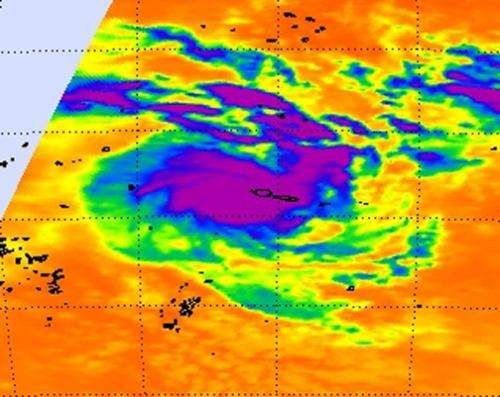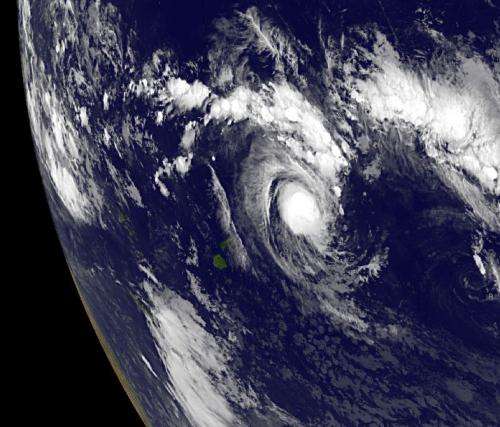NASA sees newborn Tropical Storm Evan causing trouble for American Samoa

The date 12-12-12 may be numerically significant, but for the residents of American Samoa and Fiji in the South Pacific Ocean, it means a newborn tropical storm named Evan is causing problems. NASA's Aqua satellite and NOAA's GOES-15 satellite both captured imagery of the newborn storm's cloud cover.
Tropical Storm Evan caused regional warnings to be posted on Dec. 12. In American Samoa, a gale warning and storm watch are in effect for Tutuila, Aunuu, Manua and Swains Island.
The Atmospheric Infrared Sounder (AIRS) instrument aboard NASA's Aqua satellite captured an infrared image of newborn Tropical Storm Evan over American Samoa on Dec. 12, 2012 at 12:47 UTC (7:47 a.m. EST). The strongest thunderstorms with cloud top temperatures exceeding -63F (-52C) appeared around the center of circulation and in a band of thunderstorms north and east of the center. Cloud top temperatures that cold indicate the highest, strongest storms with the heaviest rainfall within the tropical cyclone.
In addition to NASA's Aqua satellite, NOAA's GOES-15 satellite captured a visible image of newborn Tropical Storm Evan on Dec. 12, 2012 at 1500 UTC (10 a.m. EST) that showed a rounded storm.

At 1500 UTC (10 a.m. EST), Tropical Storm Evan had maximum sustained winds near 50 knots (57.5 mph/92.6 kph). Those tropical-storm-force winds extended 45 nautical miles (51.7 miles/83.3 km) from the center. The center of Evan was located near 13.9 south latitude and 173.2 west longitude, about 145 nautical miles (170 miles/268.5 km) west of Pago Pago, American Samoa. Pago Pago is the capital of American Samoa.
The National Weather Service (NWS) in Pago Pago, American Samoa noted in their forecast for Tutuila and Aunuu that the strongest winds are likely to occur there today, Dec. 12, and Thursday, Dec. 13. The NWS forecast calls for northwest winds between 35 and 45 mph (56.3 and 72.4 kph) tonight, and between 40 and 55 mph (64.3 and 88.5 kph) tomorrow, Dec. 14. Sustained winds on Dec. 15 are expected between 30 and 35 mph (48.2 and 56.3 kph). For more updated forecasts, visit: http://forecast.weather.gov/MapClick.php?zoneid=ASZ001.
Evan continues to move to the east and expected to strengthen. Evan is expected to move to the southwest and towards Fiji.
Provided by NASA's Goddard Space Flight Center



















